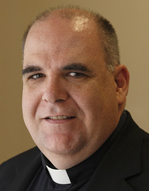Last week it was announced that Pope Francis and Patriarch Kirill of Moscow and All Russia will meet on Feb. 12. Their meeting will take place in Cuba, where the pope will make a stop on his way to Mexico for a pastoral visit, and where the Russian Orthodox Patriarch will be on an official visit.
Fifty-two years ago in Jerusalem another such “first” meeting took place, between Pope Paul VI and Patriarch Athenagoras of Constantinople. The Patriarch of Constantinople (present day Istanbul) is the “first among equals” of the Eastern Orthodox patriarchs. That meeting marked the first time in 525 years that a pope and a patriarch of Constantinople had met.
In less than two years, that historic meeting led to one of the most important steps toward reconciliation between Eastern and Western Christianity in over five centuries, with the mutual revocation of the excommunication decrees of 1054, which took place on Dec. 7, 1965. While we still do not have full unity between Orthodox and Catholic Christians, we are closer than we have been in centuries.
Even though the patriarch of Constantinople is the “first among equals” of the Eastern Orthodox patriarchs, the patriarch of Moscow represents the largest number of Orthodox faithful and is therefore of great importance in Eastern Orthodox Christianity. About two-thirds of the world’s Orthodox Christians belong to the Russian Orthodox Church. Despite previous efforts for a meeting to take place, there has never been a meeting of a pope and a patriarch of Moscow. For Pope John Paul II, such a meeting was one of the great unfulfilled desires of his pontificate.
[hotblock]
The primary difficulties between the Catholic Church and the Russian Orthodox Church include the same theological issues as with the other Orthodox churches, but also particular difficulties that are specific to Eastern Europe.
A long-standing area of disagreement is the existence of Eastern Catholic Churches. The Eastern Catholic Churches date to the late 16th century, when Christians such as those in Ukraine wanted both to be faithful to their eastern faith traditions and to the Catholic Church. The Orthodox viewed this then, and many continue to view this today, as an attempt by the Catholic Church to draw Orthodox faithful away from their Orthodox Churches.
These tensions have grown recently with the re-emergence after communism of the Ukrainian Greek Catholic Church and with the war in Ukraine.
What has changed? Why now is such a meeting possible? We are not entirely sure, but certainly the increasingly dire situation of the Christians in the Middle East, especially in Syria, is serving to bring the two sides together.
Pope Francis has opined that a “piecemeal World War III” may have already begun as the centenary of the First World War’s beginning was being commemorated. The memory of the First World War beginning a century ago from a small spark and spinning out of control involving many nations is a lesson not forgotten by Pope Francis.
Perhaps, especially with both Russian and NATO forces active in Syria, the pope and patriarch wish to discuss the potentially volatile situation. Certainly, the precarious position of the Christians in the Middle East will be at the center of the discussions. The statement that will be jointly signed by Pope Francis and Patriarch Kirill is expected to address the ongoing persecution of Christians of the Middle East and call for action to protect them.
In addition, the Orthodox and Catholic churches stand together on most contemporary moral issues, and many also expect the leaders to call for collaboration in defense of the dignity of human life and the defense of the traditional family.
We wait joyfully and expectantly for the meeting to take place, not knowing exactly what will occur, or where this will lead us. Such expectations were true in January 1964 in Jerusalem, and a long division began the long process of healing.
We hope and pray that this healing of the divisions in the church will continue with the largest Orthodox Church, trusting in the mercy of God in this Year of Mercy.
We, as the faithful, are not mere spectators in this process, but are called to be active participants. “Unitatis Redintegratio,” Vatican II’s Decree on Ecumenism, states that “the attainment of union is the concern of the whole Church, faithful and shepherds alike” and that “there can be no ecumenism worthy of the name without a change of heart. For it is from renewal of the inner life of our minds, from self-denial and an unstinted love that desires of unity take their rise and develop in a mature way. We should therefore pray to the Holy Spirit for the grace to be genuinely self-denying, humble, gentle in the service of others, and to have an attitude of brotherly generosity towards them” (cf. UR 5-7).
As we begin lent this week, please pray and offer your sacrifices in a special way for the unity of Christians, and especially for the success of this important encounter.
***
Msgr. Gregory Fairbanks teaches church history at St. Charles Borromeo Seminary. From 2008-2015 he had served as an official of the Pontifical Council for Promoting Christian Unity in Rome.




Share this story